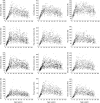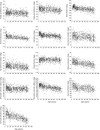Normative reference values for strength and flexibility of 1,000 children and adults
- PMID: 27881628
- PMCID: PMC5200854
- DOI: 10.1212/WNL.0000000000003466
Normative reference values for strength and flexibility of 1,000 children and adults
Abstract
Objective: To establish reference values for isometric strength of 12 muscle groups and flexibility of 13 joint movements in 1,000 children and adults and investigate the influence of demographic and anthropometric factors.
Methods: A standardized reliable protocol of hand-held and fixed dynamometry for isometric strength of ankle, knee, hip, elbow, and shoulder musculature as well as goniometry for flexibility of the ankle, knee, hip, elbow, shoulder, and cervical spine was performed in an observational study investigating 1,000 healthy male and female participants aged 3-101 years. Correlation and multiple regression analyses were performed to identify factors independently associated with strength and flexibility of children, adolescents, adults, and older adults.
Results: Normative reference values of 25 strength and flexibility measures were generated. Strong linear correlations between age and strength were identified in the first 2 decades of life. Muscle strength significantly decreased with age in older adults. Regression modeling identified increasing height as the most significant predictor of strength in children, higher body mass in adolescents, and male sex in adults and older adults. Joint flexibility gradually decreased with age, with little sex difference. Waist circumference was a significant predictor of variability in joint flexibility in adolescents, adults, and older adults.
Conclusions: Reference values and associated age- and sex-stratified z scores generated from this study can be used to determine the presence and extent of impairments associated with neuromuscular and other neurologic disorders, monitor disease progression over time in natural history studies, and evaluate the effect of new treatments in clinical trials.
© 2016 American Academy of Neurology.
Figures
References
-
- Lunn MP, Van den Bergh PY. Outcome measures in neuromuscular disease: is the world still flat? J Peripher Nerv Syst 2015;20:255–259. - PubMed
-
- Mercuri E, Messina S, Pane M, Bertini E. Current methodological issues in the study of children with inherited neuromuscular disorders. Dev Med Child Neurol 2008;50:417–421. - PubMed
-
- Roach KE, Miles TP. Normal hip and knee active range of motion: the relationship to age. Phys Ther 1991;71:656–665. - PubMed
-
- Hallaceli H, Uruc V, Uysal HH, et al. . Normal hip, knee and ankle range of motion in the Turkish population. Acta Orthop Traumatol Turc 2014;48:37–42. - PubMed
-
- Sengupta P, De S, Pal A, Maity P, Banerjee M, Dhara PC. Variation of range of joint motion in Bengalee (Indian) healthy adult subjects. J Life Sci 2012;4:123–133.
Publication types
MeSH terms
LinkOut - more resources
Full Text Sources
Other Literature Sources
Medical


